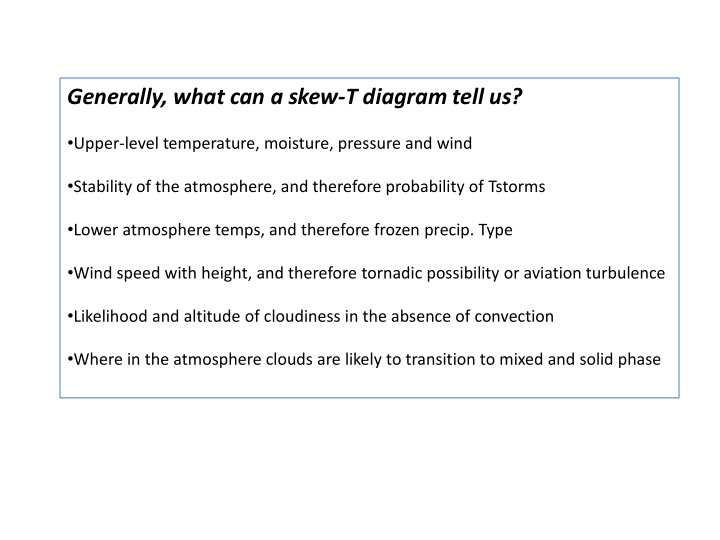



Generally, what can a skew-T diagram tell us? • Upper-level temperature, moisture, pressure and wind • Stability of the atmosphere, and therefore probability of Tstorms • Lower atmosphere temps, and therefore frozen precip. Type • Wind speed with height, and therefore tornadic possibility or aviation turbulence • Likelihood and altitude of cloudiness in the absence of convection • Where in the atmosphere clouds are likely to transition to mixed and solid phase
Specifically, what markers are we looking for? • T and Td at any level • Wind speed and dir at any level • Lapse rates at various levels • LCL: Lifting Condensation Level • CCL: Convective Condensation Level • LFC: Level of Free Convection • CAPE: Convective Available Potential Energy • CIN: Convective Inhibition • EL: Equilibrium Level • MPL: Max. Parcel Height • FZL: Freezing Level • WBZ: Wet Bulb Zero Level • PW: Precipitable Water • CONVT: Convective Temperature
Lifting Condensation Level? • Follow the surface mixing ratio upwards until it intersects with the dry adiabatic lapse rate of the lifted (and cooling) surface parcel • This intersection indicates that the parcel has been lifted to its saturation mixing ratio and condensation will occur • This estimates the cloud base from surface convection or surface-lifting • Try it on your skew-T – what do you get
Convective Condensation Level? • Follow the surface mixing ratio upwards until it intersects with the temperature sounding itself. • This intersection indicates that the saturation is reached in a parcel rising from the surface on its own later in the day – this parcel would have to be warmer than the surface at the time of the sounding, which results in a higher cloud base • This estimates the cloud base from afternoon surface convection better than the LCL • Try it on your skew-T – what do you get
Level of Free Convection: • From the LCL, the parcel will now cool along a moist adiabat • Follow the moist adiabat until the parcel’s Temperature crosses that of the environment • At this point the parcel is buoyant and an updraft will result • This won’t occur on soundings that are stable • Find the LFC on your skew-T
Convective Available Potential Energy? • Find the area between the parcel and environment above the LFC until the temperatures intersect again. • Because temperature is proportional to density, this equation integrates buoyancy force X distance which is an energy • This “potential energy” gets converted to kinetic energy in the updraft • Greater CAPE = stronger updrafts and storms • Difference between “tall and skinny and tall and fat CAPE” • This is the best measurement of instability for storm formation • Shade the CAPE on your skew T
Convective Inhibition? • CIN is pretty much the opposite of CAPE – this is negative buoyancy area that acts to prevent convection • This is the area between the environmental and parcel temperature that is below the LFC, where the parcel is colder • Greater values of CIN require extraordinary lifting to get through • Some moderate CIN can actually promote explosive storm development if there is big CAPE above the CIN • Like busting down a door
Equilibrium Level? • EL is the second crossing of parcel and environmental Temperature • The parcel is now neutrally buoyant – it is still moving up, but no longer accelerating • This is where the cloud top starts to slow down its upward movement • Try it on your skew-T – what do you get
Max. Parcel Level? • MPL is the highest level a convective cloud might reach if it taps into all of the available instability • This occurs where the negative bouyancy above the EL balances out the CAPE below it…the parcel is decelerated to zero. • This is the maximum convective cloud top height – an important parameter for aviation. The higher the cloud top, the greater the updraft must have been. • Try it on your skew-T – what do you get
Freezing Level • FZL The height/pressure where the sounding indicates that the environment drops below 0 C • Above this temperature, mixed phase clouds are possible • Convective clouds likely need to reach at least -20 C to beginning generating charge separation • Cirrus clouds are not likely until you reach -30 C • The location of this level is important in marginal frozen precip. forecasts • Try it on your skew-T – what do you get
Wet bulb zero level • WBZ is the level where the wet-bulb temperature of the environment is 0 C • This is an important value for determining frozen precip. type • Falling precipitation causes evaporative cooling of the surrounding air – the wet bulb temperature shows how much cooling potential exists. This effect allows “dynamic cooling” during heavy precipitation and may permit snow even if the sounding shows marginally above freezing temps. • Try it on your skew-T – what do you get
Precipitable Water? • PW is an integration of the total amount of water vapor in the sounding if it where all condensed • Greater precipitable water is likely to promote heavy rain events • Not easy to estimate on your own – just read it off the plot analysis
Convective Temperature • This is the temperature the surface would have to reach so that the parcel could rise on its own – essentially bringing the LFC to the surface • If this value is indicated on a morning sounding and the expected afternoon temperature is greater than this value, convection is highly likely.
Where can you get skew- T’s and cloud height information? • Storm Prediction Center — Forecast tools • NOAA UCAR – upper air data
Recommend
More recommend